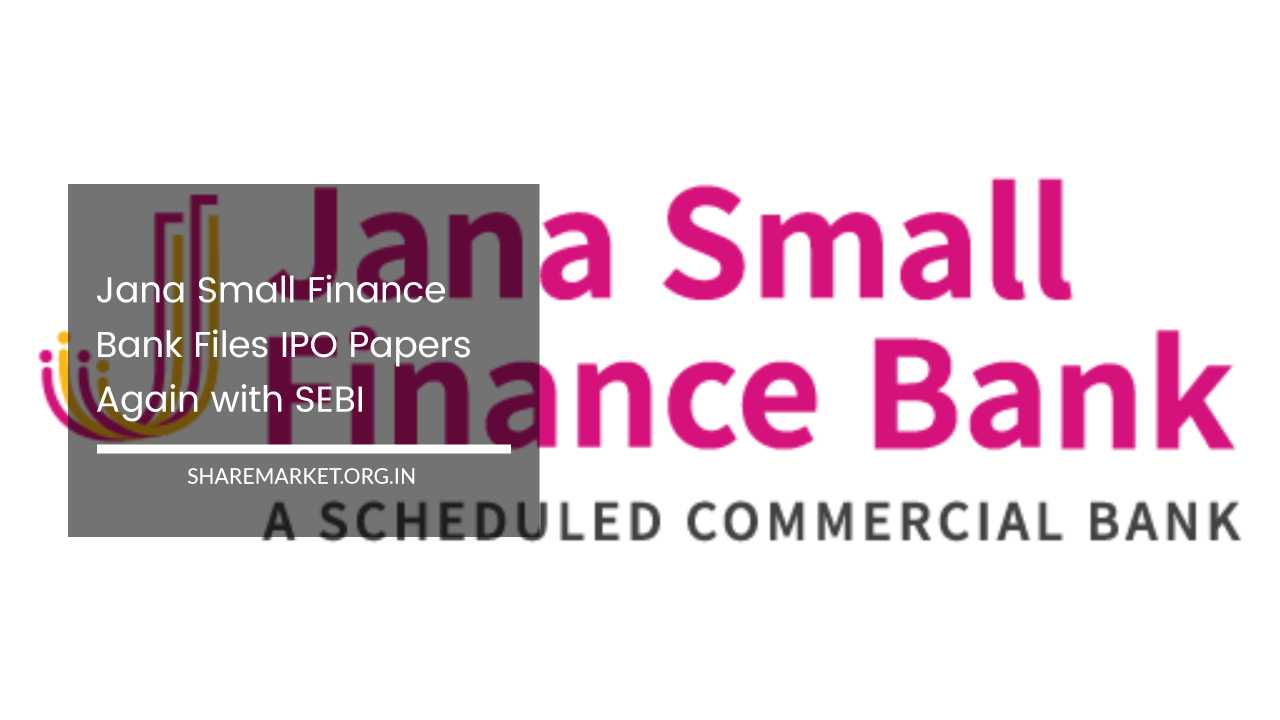Jana Small Finance Bank Files IPO Papers Again with SEBI

Jana Small Finance Bank IPO
Jana Small Finance Bank Set to Launch IPO Amidst Resilient Recovery
Jana Small Finance Bank, a leading microfinance institution in India, is gearing up to bring its Initial Public Offering (IPO) to the market, marking a significant milestone in its growth journey.
The company has once again filed a draft paper with the market regulator, Securities and Exchange Board of India (SEBI), signaling its readiness to go public.
The IPO will see the issuance of fresh equity shares worth Rs 575 crore, demonstrating the company’s confidence in its future prospects.
In addition to the fresh equity issuance, the IPO will also include an Offer for Sale (OFS) of 40.5 lakh shares by existing shareholders and promoters of the company.
The OFS provides an opportunity for these stakeholders to divest a portion of their holdings, while at the same time allowing new investors to participate in the bank’s growth story.
The decision to proceed with the IPO comes after a brief postponement earlier due to adverse market conditions caused by the COVID-19 pandemic.
The management and board of Jana Small Finance Bank have meticulously analyzed market dynamics and evaluated the current economic environment before reviving their plans for the IPO.
The IPO-related details highlight the participation of various stakeholders in the OFS segment. Under the IPO, Client Rosehill Limited will sell 17.6 lakh shares, CVCIGP II Employee Rosehill Limited will sell 9.3 lakh shares, Hero Enterprise Partner Ventures will sell 12.2 lakh shares, and Global Impact Funds will sell 1.44 lakh shares.
The involvement of established entities in the OFS reflects their confidence in the bank’s future growth potential.
Axis Capital Limited, ICICI Securities Limited, and SBI Capital Markets Limited have been appointed as the Book Running Lead Managers to the Issue, overseeing the entire IPO process and ensuring smooth execution.
Their expertise in handling IPOs of various companies gives investors the assurance that the offering will be professionally managed and compliant with all regulatory requirements.
Despite facing unprecedented challenges from the COVID-19 pandemic, Jana Small Finance Bank has displayed remarkable resilience and rapid recovery.
The bank’s ability to adapt swiftly to the changing landscape has positioned it well for growth in a post-pandemic era.
Notably, in FY23, Jana SFB reported a significant increase in net profit, reaching Rs 256 crore, compared to a mere Rs 17.47 crore in the previous fiscal year.
The bank’s ability to manage its non-performing assets (NPAs) has also been commendable, as it managed to bring down the NPA ratio to 3.94 per cent from 5.71 per cent a year ago.
This feat reflects the bank’s prudent risk management practices and the efficacy of its recovery mechanisms.
To ensure sustainable growth and reduce dependency on a single product, Jana SFB has taken strategic measures to diversify its loan portfolio.
In its initial years of operation, the bank relied heavily on microfinance, with nearly 95 per cent of its portfolio comprising microfinance loans.
However, recognizing the importance of diversification, the bank has reduced its microfinance exposure to 25 per cent, mitigating concentration risk and enhancing financial stability.
The bank’s decision to diversify its portfolio has paid off, as seen in the growth of its gross advances, which increased by 35 per cent from Rs 13,000 crore to Rs 18,000 crore.
Additionally, deposits recorded substantial growth, reaching Rs 16,334 crore, reflecting a year-on-year growth of 20.7 per cent.
This increased deposit base further strengthens the bank’s ability to meet its funding requirements and support its lending activities.
The bank has also made notable progress in enhancing its deposit mix, with the CASA ratio (Current Account Savings Account) improving from 22.52 per cent to 16.3 per cent.
CASA deposits are considered more stable and cost-effective compared to term deposits, which is a positive sign for the bank’s profitability and liquidity management.
As of the latest financial reports, Jana Small Finance Bank’s total assets stand at an impressive Rs 19,600 crore.
This diverse asset base includes home loans, gold loans, and secured business loans, indicating the bank’s commitment to providing a comprehensive suite of financial services to its customers.
The success of the IPO will likely reinforce the bank’s growth trajectory and provide additional capital to expand its operations and offerings.
With a stronger capital base, the bank will be better equipped to explore new market segments and geographies, ultimately boosting its competitive position in the banking sector.
Jana Small Finance Bank’s IPO launch not only represents a landmark event for the company but also for the Indian banking sector as a whole.
It is expected to garner significant interest from institutional investors, retail investors, and other market participants who seek to invest in the growing Indian economy.
As the bank embarks on its IPO journey, it will need to navigate various challenges, including volatile market conditions, investor expectations, and regulatory compliance.
However, with its proven track record of resilience and prudent business strategies, Jana Small Finance Bank appears well-prepared to capitalize on the opportunities that the IPO presents.
Looking beyond the IPO, the bank’s management has expressed interest in exploring the possibility of obtaining a universal banking license.
This move, if successful, would allow the bank to offer a broader range of banking services, including accepting demand and term deposits and engaging in other banking activities.
In conclusion, Jana Small Finance Bank’s decision to bring its IPO to the market showcases its determination to accelerate growth and strengthen its position in the Indian banking sector.
As the bank progresses through the IPO process, investors and industry experts will keenly observe its performance and prospects, anticipating a successful and transformative IPO for one of India’s leading microfinance institutions.

















